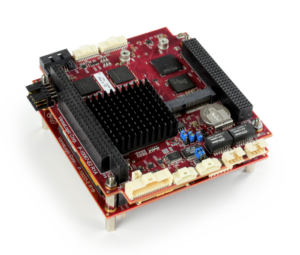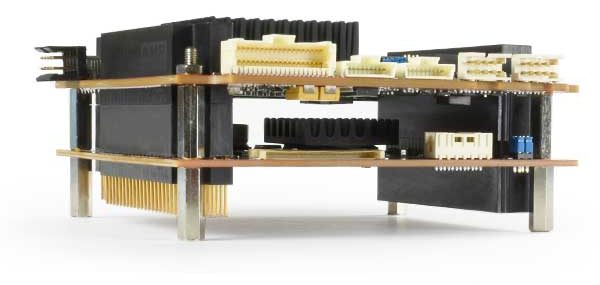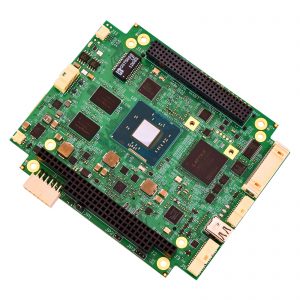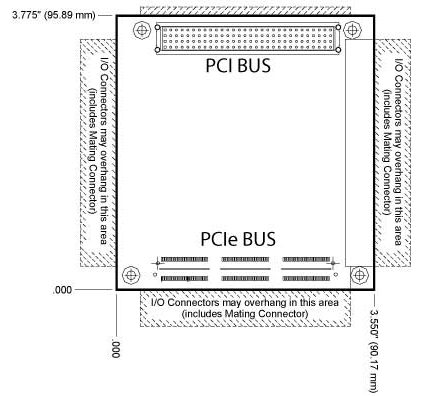
Find the solution to your next embedded design challenge
Rugged, compact, expandable. The PC104 is an industry-standard form factor with many advantages – stable, reliable,
flexible, expandable, and rugged – something you’re looking for in your next system design.
PC104 the future of small-form-factor design
The PC/104 form factor actually includes a number of family members. They are all the same size and have the same mounting points, but they differ in the type of expansion connectors they use. New family members have been added over time as faster busses become available.
For example, one version includes a PCI expansion connector. Another version includes a PCI Express connector. The latter can interface with expansion boards that run at much higher speeds. On the other hand, slower speed interfaces can be easier to design around for customized I/O functions.

What are PC/104 boards?
 Rugged, compact, expandable embedded computers; that’s the essence of the PC/104 family of products.
Rugged, compact, expandable embedded computers; that’s the essence of the PC/104 family of products.
The PC/104 specifications define products that can interconnect with each other for compatibility across the wide number of manufacturers that support the platform. The PC/104 format, with its 90 x 96 mm (3.6 by 3.8″) footprint, provides compact and expandable processing for a wide variety of applications that need high reliability computing, or other advantages like off-the-shelf availability (why build it when you can buy it!). The small size and the self-stacking nature of expansion boards offer a unique combination of attributes around which to build reliable, rugged, OEM systems.
What are PC/104 products used for?
PC/104 processor boards and expansion cards can be used in variety of OEM applications ranging from defense systems to industrial automation, to utility applications.
In many case a single processor board can be used. PC/104 processor boards are true SBCs (Single Board Computers). They can run on their own without any carriers, backplanes, or add-on boards. This greatly simplifies system design, bring-up, and production troubleshooting.Most PC/104 SBCs include numerous on-board I/O ports, such as USB and Ethernet. Many PC/104 systems consist of just a single processor board and no expansion cards. If additional or specialized I/O is required, expansion is as easy as stacking it up. No additional connectors are needed.. There are several PC/104 types that support different expansion bandwidths. The latest interconnect version supports PCIe Gen 3 x16 signals.
Who should use PC/104 products?
If your OEM application requires a rugged, proven, compact form factor to deal with high levels of mechanical stress, then PC/104 is right for you. Due to its size and mechanical design, the PC/104 format is inherently rugged and durable. The mounting points, connectors used, and small cross section, limit board flex and provide excellent performance in high shock and vibration environments. PC/104 processor boards are available from a number of manufacturers, in a wide range of performance levels, with incredible amounts of on-board I/O. Take a look at what is packed on a single PC/104 processor card.
Are there other advantages?
Rugged PC/104 boards are ideal for mechanically stressful applications

The inherent rugged and compact nature of PC/104 makes it ideal for mechanically stressful environments
Time to market!
PC/104 manufacturers may offer customization services but their stock in trade is the supply of off-the-shelf products which are already designed and tested. A huge advantage with PC/104 products is being able to pick and choose an excellent embedded computer board from a wide selection of suppliers, and then immediately design a new system around it. Purchasing existing designs off-the-shelf typically cuts 12 months or more off of project development time, compared with designing a processor board from scratch.
Flexibility!
Whether it’s during initial development, or years later when you’re adding new features to your product, the flexibility of the PC/104 platform is a big advantage. The ability to add on new I/O functions, without changing the rest of the existing system, is a major advantage. Alternatively if you want to retain an existing I/O configuration, but upgrade the system with a more powerful processor, PC/104 supports that as well.
PC/104 also enables OEMs to standardize on a common CPU platform, but to use different I/O configuration for various products in their portfolio. There are a wide range of CPU options available in PC/104 format, including frugal low-power X86 processors through Intel®’s Atom, Core and even Xeon family processors.
Where can I get them?
PC/104 processor and I/O expansion products are available from a wide range of vendors. The large PC/104 ecosystem makes it easy to configure and assemble a complete system, even with specialized I/O functions, in record time. See our Member List for links to member sites.
What is the PC/104 Consortium?
Exacting specifications assure compatibility between PC/104 familiesThe PC/104 Consortium is an industry trade group that develops and sets standards for various PC/104 products. The carefully designed and tested specifications ensure mechanical and electronic compatibility across all the suppliers that design and manufacture PC/104 products.
If you would like to learn more about becoming a PC/104 Consortium member, using any of the PC/104 standards, or participating in the development of future product specifications, please contact the Consortium at Info@PC104.org.
Frequently Asked Questions
How do PC/104 products compare to Raspberry Pi boards?
PC/104 and Raspberry Pi are similar in that they are both full SBCs that are ready to power-up out of the box. However, compared with Raspberry Pi, the PC/104 eco-system consists of a wide range of processor types and performance levels that are compatible with a wide range of desktop and real-time operating systems.
How do PC/104 products compare to COM Express products?
Unlike Com Express, a PC/104 board is a full SBC with processor and its own complement of on-board I/O. With COM Express it’s necessary to pair a COM (CPU) board with a custom-made I/O board, and get them working together; all of which adds to the bring-up time for a new project. Additionally PC/104 is more expandable. With COM Express once a COM has been mated to an I/O board there is no more expansion for stacking. In the case of PC/104 it’s simple to continue to add more I/O or storage by stacking more off-the-shelf modules from the wide range of suppliers.
Are they good for industrial automation projects?
Yes, the inherent ruggedness of PC/104 is a big plus in harsh environment s. In addition the extensive range of expansion options makes it easy to configure a controller with the desired features right off the shelf without resorting to custom designs.

